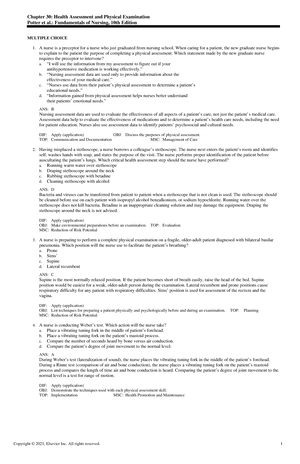- Information
- AI Chat
Was this document helpful?
Capstone leadership pre assessment
Course: Foundations Of Nursing (NURS 101)
98 Documents
Students shared 98 documents in this course
University: Ohio University
Was this document helpful?

Leadership and community health
Pre assessment
Question: 2 of 30
https://wwwn.cdc.gov/nndss/conditions/notifiable/2019/
A community health nurse is reviewing information about infectious diseases with
the nurses on her team. The nurse should remind the team that which of the
following diseases are included in the list of nationally notifiable infectious
diseases?
Trichomonas vaginalis is a sexually transmitted infection that occurs in women
more often than men, but it is not on the list of nationally notifiable infectious
diseases.
Chlamydia is a sexually transmitted infection. When a client is diagnosed with
chlamydia, the public health department is notified so that sexual partners can be
notified and treated.
Gonorrhea is a sexually transmitted infection. When a client is diagnosed with
gonorrhea, the public health department is notified so that sexual partners can be
notified and treated.
Chancroid is a sexually transmitted infection. When a client is diagnosed with
chancroid, the public health department is notified so that sexual partners can be
notified and treated.
Candidiasis albicans is a yeast infection which can affect the vagina, but it is not
on the list of nationally notifiable infectious diseases.
Lyme disease is a nationally notifiable infectious disease.
In the event of a fire, it is helpful to recall the mnemonic RACE to prioritize the actions to take: R -
Rescue and remove the clients, A - Activate the alarm, C - Confine the fire, and E - Extinguish the
fire.
The nurse’s priority action is to remove the clients from the room.
The nurse should then sound the fire alarm and close the door to confine the fire.
Finally and if possible, the nurse should extinguish the fire.
Sarin is incorrect. Sarin is a chemical – rather than a biological – agent of mass destruction.
Smallpox is correct. Smallpox is a biological weapon of mass destruction.
Anthrax is correct. Anthrax is a biological weapon of mass destruction.
Students also viewed
- Qs palliative care clinical guide en
- 101 ways of scoring high on the nclex
- V Sim2 - documentation questions
- Adult Medical and Surgical
- Chapter 05 Nclex-RN® Examination and the New Graduate Flashcards Quizlet
- Nursing Leadership Ch 4 Employment Considerations Opportunities, Resumes, and Interviewing Flashcards Quizlet







